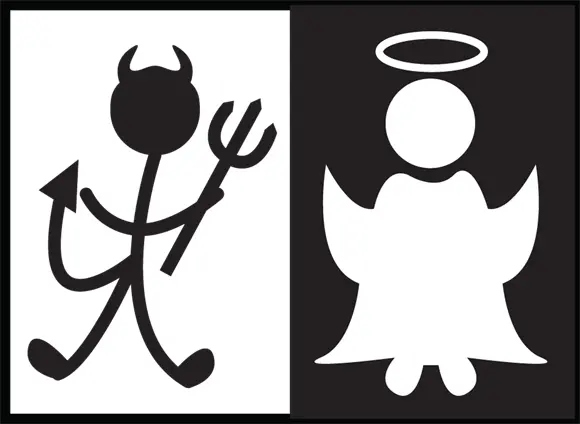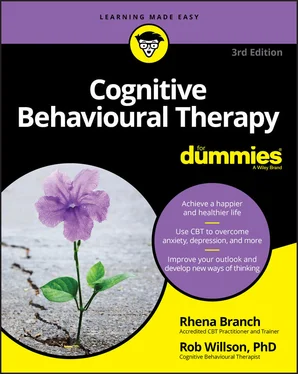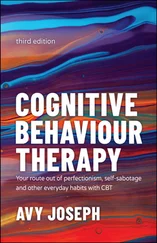To err is most definitely human. Or, as American psychotherapist Albert Ellis is quoted as saying, ‘If the Martians ever find out how human beings think, they’ll kill themselves laughing’. Ellis made that observation back in the ’60s, but not a lot has changed about our tendency to ‘think badly’ since. By understanding the thinking errors we outline in this chapter, you can spot your unhelpful thoughts and put them straight more quickly. Get ready to identify and respond in healthier ways to some of the most common ‘faulty’ and unhelpful ways of thinking identified by researchers and clinicians.
 Albert Ellis was one of the founders of cognitive-based psychotherapy. He developed a treatment for emotional disorders called Rational Emotive Behaviour Therapy or REBT. A long-winded name, no doubt, but it basically involves much of what is in this book. Alongside Aaron Beck, who developed CBT for the treatment of depression and later further popularized CBT, Ellis developed the underlying philosophical foundations that still comprise CBT today. So if you are very keen on learning more about how CBT developed, look for books by Ellis and early work by Beck. You may also want to look at books by Windy Dryden, who has over 200 publications on the subject.
Albert Ellis was one of the founders of cognitive-based psychotherapy. He developed a treatment for emotional disorders called Rational Emotive Behaviour Therapy or REBT. A long-winded name, no doubt, but it basically involves much of what is in this book. Alongside Aaron Beck, who developed CBT for the treatment of depression and later further popularized CBT, Ellis developed the underlying philosophical foundations that still comprise CBT today. So if you are very keen on learning more about how CBT developed, look for books by Ellis and early work by Beck. You may also want to look at books by Windy Dryden, who has over 200 publications on the subject.
Catastrophising: Turning Mountains Back Into Molehills
Catastrophising is taking a relatively minor negative event and imagining all sorts of disasters resulting from that one small event, as we sum up in Figure 2-1.
Consider these examples of catastrophising:
You’re at a party and you accidentally stumble headlong into the ice sculpture. After you slide your way across the floor and to the bathroom to clean up, you scurry home and conclude that everyone at the party witnessed your little trip and laughed at you.
You’re waiting for your teenage daughter to return home after an evening at the cinema with friends. The clock strikes 10:00 p.m., and you hear no reassuring rattle of her key in the door. By 10:05 p.m., you start imagining her accepting a lift home from a friend who drives recklessly. At 10:10 p.m., you’re convinced she’s been involved in a head-on collision and paramedics are at the scene. By 10:15 p.m., you’re weeping over her grave.© John Wiley & Sons, Inc. FIGURE 2-1:Catastrophising.
Your new partner declines an invitation to have dinner with your parents. Before giving him a chance to explain his reasons, you put down the phone and decide that this is his way of telling you the relationship’s over. Furthermore, you imagine that right now he’s ringing friends and telling them what a mistake it was dating you. You decide you’re never going to find another partner and will die old and lonely.
Catastrophising leads many an unfortunate soul to misinterpret a social faux pas as a social disaster, a late arrival as a car accident or a minor disagreement as total rejection.
Nip catastrophic thinking in the bud by recognising it for what it is – just thoughts. When you find yourself thinking of the worst possible scenario, try the following strategies:
Put your thoughts in perspective. Even if everyone at the party did see your ice-scapade, are you sure no one was sympathetic? Surely you aren’t the only person in the world to have tripped in public. Chances are, people are far less interested in your embarrassing moment than you think. Falling over at a party isn’t great, but in the grand scheme of things it’s hardly society-page news.
Consider less terrifying explanations. What other reasons are there for your daughter being late? Isn’t being late for curfew a common feature of adolescence? Perhaps the film ran over, or she got caught up chatting and forgot the time. Don’t get so absorbed in extreme emotions that you’re startled to find your daughter in the doorway apologising about missing the bus.
Weigh up the evidence. Do you have enough information to conclude that your partner wants to leave you? Has he given you any reason to think this before? Look for evidence that contradicts your catastrophic assumption. For example, have you had more enjoyable times together than not? Isn’t dinner with the parents something a lot of partners may want to avoid due to nerves or some other reason?
Focus on what you can do to cope with the situation, and the people or resources that can come to your aid. Engaging in a few more social encounters can help you put your party faux pas behind you. You can repair a damaged relationship – or find another. Even an injury following an accident can be fixed with medical care.
 No matter how great a calamity you create in your mind, the world’s unlikely to end because of it – even if your catastrophic fear comes to pass. You’re probably far more capable of surviving embarrassing and painful events than you give yourself credit for – human beings can be very resilient. Often people say that they can’t imagine dealing with a tragedy like losing a loved one or perhaps developing a terminal illness, even when they know other people just like them who are dealing with their own tragedies. You don’t always need to be able to imagine coping with a negative event to be able to do so if the time comes. Sometimes you just need to have faith that your coping resources will be there if and when you need them.
No matter how great a calamity you create in your mind, the world’s unlikely to end because of it – even if your catastrophic fear comes to pass. You’re probably far more capable of surviving embarrassing and painful events than you give yourself credit for – human beings can be very resilient. Often people say that they can’t imagine dealing with a tragedy like losing a loved one or perhaps developing a terminal illness, even when they know other people just like them who are dealing with their own tragedies. You don’t always need to be able to imagine coping with a negative event to be able to do so if the time comes. Sometimes you just need to have faith that your coping resources will be there if and when you need them.
All-or-Nothing Thinking: Finding Somewhere In-between
All-or-nothing or black-or-white thinking (see Figure 2-2) is extreme thinking that can lead to extreme emotions and behaviours. People either love you or hate you, right? Something’s either perfect or a disaster. You’re either responsibility-free or totally to blame. Sound sensible? We hope not!
Unfortunately, humans fall into the all-or-nothing trap all too easily:
Imagine you’re trying to eat healthily and you cave in to the temptation of a doughnut. All-or-nothing thinking may lead you to conclude that your plan is in ruins and then to go on to eat the other 11 doughnuts in the pack.
You’re studying a degree course and you fail one module. All-or-nothing thinking makes you decide that the whole endeavour is pointless. Either you get the course totally right or it’s just a write-off.

© John Wiley & Sons, Inc.
FIGURE 2-2:All-or-nothing thinking.
 Consider the humble thermometer as your guide to overcoming the tendency of all-or-nothing thinking. A thermometer reads degrees of temperature, not only ‘hot’ and ‘cold’. Think like a thermometer – in degrees, not extremes. You can use the following pointers to help you change your thinking:
Consider the humble thermometer as your guide to overcoming the tendency of all-or-nothing thinking. A thermometer reads degrees of temperature, not only ‘hot’ and ‘cold’. Think like a thermometer – in degrees, not extremes. You can use the following pointers to help you change your thinking:
Be realistic. You can’t possibly get through life without making mistakes. One doughnut doesn’t a healthy diet ruin. Remind yourself of your goal, forgive yourself for the minor slip and resume your diet.
Develop ‘both–and’ reasoning skills. An alternative to all-or-nothing thinking is both–and reasoning. You need to mentally allow two seeming opposites to exist together. You can both succeed in your overall educational goals and fail a test or two. Life is not a case of being either a success or a failure. You can both assume that you’re an okay person as you are and strive to change.
Читать дальше

 Albert Ellis was one of the founders of cognitive-based psychotherapy. He developed a treatment for emotional disorders called Rational Emotive Behaviour Therapy or REBT. A long-winded name, no doubt, but it basically involves much of what is in this book. Alongside Aaron Beck, who developed CBT for the treatment of depression and later further popularized CBT, Ellis developed the underlying philosophical foundations that still comprise CBT today. So if you are very keen on learning more about how CBT developed, look for books by Ellis and early work by Beck. You may also want to look at books by Windy Dryden, who has over 200 publications on the subject.
Albert Ellis was one of the founders of cognitive-based psychotherapy. He developed a treatment for emotional disorders called Rational Emotive Behaviour Therapy or REBT. A long-winded name, no doubt, but it basically involves much of what is in this book. Alongside Aaron Beck, who developed CBT for the treatment of depression and later further popularized CBT, Ellis developed the underlying philosophical foundations that still comprise CBT today. So if you are very keen on learning more about how CBT developed, look for books by Ellis and early work by Beck. You may also want to look at books by Windy Dryden, who has over 200 publications on the subject. No matter how great a calamity you create in your mind, the world’s unlikely to end because of it – even if your catastrophic fear comes to pass. You’re probably far more capable of surviving embarrassing and painful events than you give yourself credit for – human beings can be very resilient. Often people say that they can’t imagine dealing with a tragedy like losing a loved one or perhaps developing a terminal illness, even when they know other people just like them who are dealing with their own tragedies. You don’t always need to be able to imagine coping with a negative event to be able to do so if the time comes. Sometimes you just need to have faith that your coping resources will be there if and when you need them.
No matter how great a calamity you create in your mind, the world’s unlikely to end because of it – even if your catastrophic fear comes to pass. You’re probably far more capable of surviving embarrassing and painful events than you give yourself credit for – human beings can be very resilient. Often people say that they can’t imagine dealing with a tragedy like losing a loved one or perhaps developing a terminal illness, even when they know other people just like them who are dealing with their own tragedies. You don’t always need to be able to imagine coping with a negative event to be able to do so if the time comes. Sometimes you just need to have faith that your coping resources will be there if and when you need them.











